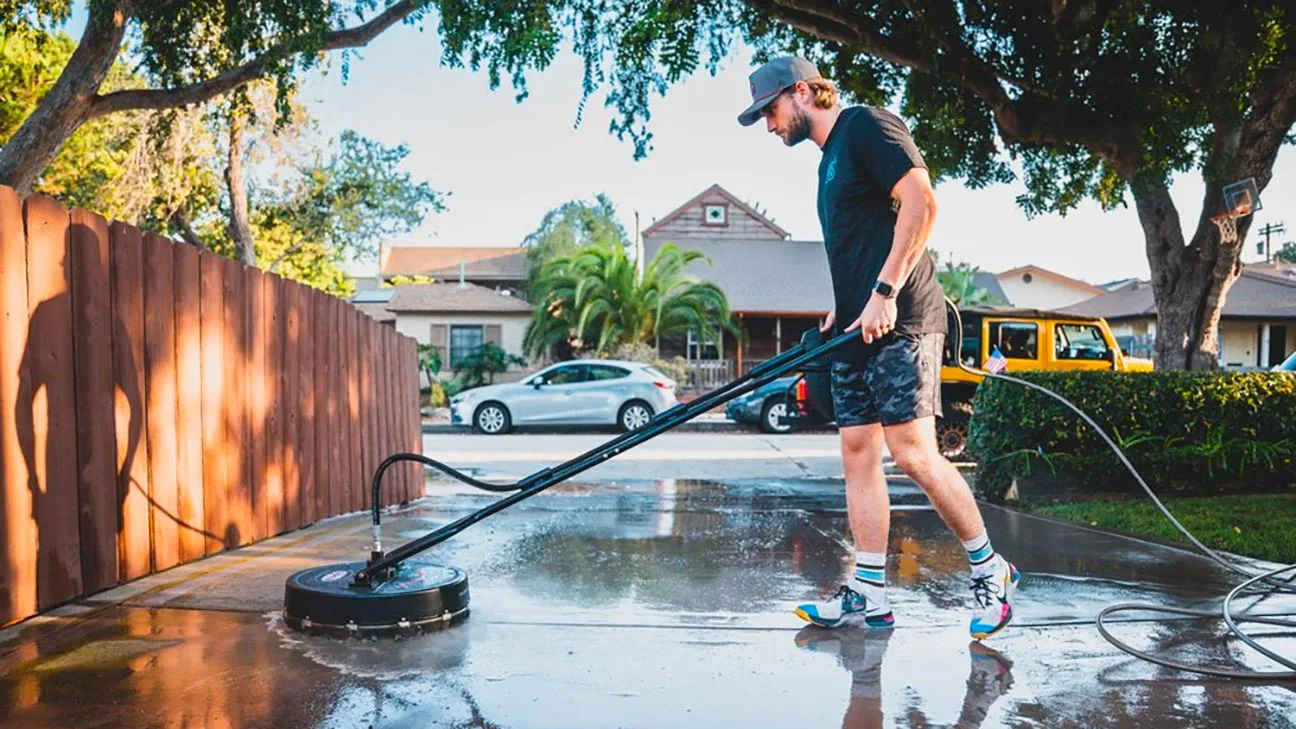Ever wrapped up a pressure washing project and wondered how to prep your machine for storage? Draining the water properly is key to preventing damage and keeping your washer in tip-top shape. Luckily, it’s a super simple process that takes just a few minutes! In this guide, we’ll walk you through the steps of How to Drain Water Out of Pressure Washer Washer, ensuring it’s ready to tackle your next cleaning challenge.
What is a Pressure Washing Services?
Pressure washing services are essentially professional deep cleaning using a powerful blast of water. Imagine a heavy-duty shower that can strip away dirt, grime, mold, and even loose paint from a variety of surfaces.
These services are a popular choice for homeowners and businesses alike because they can significantly improve the look and feel of your property. They also offer some practical benefits like:
Safety
Pressure washing removes slippery substances like mold and mildew that can cause slip and fall hazards.
Curb Appeal
A clean exterior makes a great first impression, whether it’s your house or your business storefront.
Maintenance
Pressure washing can help remove damaging substances that can eat away at surfaces over time. Common areas that pressure washing services tackle include driveways, decks, patios, siding, roofs (with a softer washing technique), and even fences and retaining walls.
Safety First: Gear Up Like a Pro
Before you unleash your inner drainage master, safety is paramount. Here’s your pressure washer draining battle gear:
- Safety glasses: Water might not be your enemy, but a rogue splash could sting your eyes.
- Gloves: Protect your precious hands from any unexpected abrasions or cleaning solution residue.
- A bucket or container: To catch the drained water – think of it as your trusty sidekick.
- Rags or towels: For any spills or drips – you wouldn’t want your cleaning hero to leave a watery mark, would you?
The Great Drain Out: A Step-by-Step Guide
With your safety gear secured, it’s time to tackle the water. Here’s a breakdown of the typical draining process:
Power Down and Disconnect
Turn off and unplug your pressure washer. Disconnect the water supply hose from the spigot. Remember, never run a pressure washer without a flowing water source.
Release the Pressure
Squeeze the trigger on the spray gun repeatedly until you hear no more water spraying out and there’s no pressure left in the system. Think of it as disarming your pressure washer before the big drain.
Detach the Hoses
Unhook the high-pressure hose from the spray gun and the pump. Some hoses might have quick-connect fittings, while others may require a wrench to loosen the connection.
Drain the Hoses
Hold the hose ends downwards and let gravity do its magic. You can also walk the hose away from the pressure washer, keeping the trigger end open, to help expel any remaining water.
Drain the Pump
This step might not be necessary for all models, so refer to your manual. Some pressure washers have a dedicated drain plug on the pump itself. If yours does, place your bucket underneath and carefully loosen the plug to allow any trapped water to drain.
Tilt and Tip
Here’s a secret weapon – gently tilt your pressure washer forward and backward a few times. This helps dislodge any stubborn water droplets hiding inside the pump and other components.
Dry It Up
Use rags or towels to wipe down any remaining water on the pressure washer itself. Moisture can be the enemy, so leaving your washer sparkling dry is a great finishing touch.
Winterize for Extra Protection
If you’re storing your pressure washer for the winter, consider taking an extra step for ultimate protection. You can find special pump-saver antifreeze solutions specifically designed for pressure washers pressure washer antifreeze. These solutions help prevent internal components from freezing and cracking during cold weather.
Remember, when in doubt, consult the manual. Think of it as your pressure washer’s secret decoder ring, unlocking the specific draining instructions for your model.
Keeping Your Pressure Washer in Top Shape: A Champion’s Maintenance Guide
Your pressure washing services are a cleaning warrior, conquering dirt, grime, and mystery stains with a powerful blast of water. But even the mightiest heroes need regular maintenance to stay in peak condition. Just like taking care of your car ensures a smooth ride, proper maintenance keeps your pressure washer performing optimally for years to come.
Drain the Water
This might sound obvious after our previous discussion, but it’s worth repeating. Regularly draining the water, especially before storage, prevents internal damage from freezing temperatures or stagnant water build-up. Refer to your manual for specific draining instructions for your model.
Filter Frenzy
Pressure washers have filters to trap debris in the water supply, protecting the pump and internal components. Check and clean your filters regularly (usually after each use) according to your manual’s recommendations. Dirty filters can restrict water flow and reduce cleaning power.
Oil Changes
Gas-powered pressure washers require oil changes at specific intervals, just like your car. Refer to your manual for the recommended oil type and change schedule. Fresh oil ensures smooth operation and protects the engine from wear and tear.
Nozzle Know-How
The nozzle is the business end of your pressure washer, shaping the water stream for different cleaning tasks. Inspect the nozzle for clogs or damage after each use. A clogged nozzle can affect spray pattern and cleaning efficiency. Clean the nozzle with a needle or compressed air, and replace it if damaged.
Hose Heroes
Hoses are the lifeline of your pressure washer, delivering water to the pump. Inspect the hoses regularly for cracks, leaks, or bulges. Damaged hoses can be dangerous and affect performance. Replace worn-out hoses to maintain pressure and safety.
Connection Check-Up
Tighten all the connections on your pressure washer regularly. Loose connections can cause leaks and reduce cleaning power.
If you’re curious about: “Do You Need a Surface Cleaner for Pressure Washer?” Visit our blog page today to learn all about it!
Beyond the Basics: Advanced Maintenance Tips
For the truly dedicated pressure washer enthusiasts, here are some extra steps to take your maintenance game to the next level:
Soap Savvy: If you use cleaning solutions with your pressure washer, flush the system with clean water after each use. This removes any soap residue that could clog components over time.
Winter Warrior: If you live in a cold climate, consider using a pump saver antifreeze before storing your pressure washer for the winter. This special solution protects internal components from freezing and potential damage.
The Power of the Manual: Your pressure washer’s manual is a treasure trove of information. Refer to it for specific maintenance instructions, troubleshooting tips, and recommended parts for your model. Think of it as the owner’s guide to your pressure washing cleaning champion.
Conclusion
When in doubt, call in the professionals! Pressure washing companies can offer maintenance services or troubleshoot any issues you might encounter. They have the expertise and tools to keep your pressure washer functioning at its best. Draining your trusty Proclean pressure washer is a snap! Think of it as the cool-down lap after a cleaning marathon. Just disconnect the hose, squeeze the trigger to release any pressure, and maybe tilt your Proclean friend a bit to get out any leftover water. Consult your Proclean manual for any specifics, and voila! Your pressure washer will be prepped and ready for its next cleaning adventure.
[/fsn_text][/fsn_column][/fsn_row]




